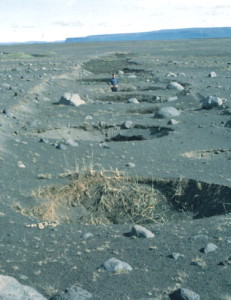
— pit crater chain in Iceland (from Fig 3 of Ferrill et al., 2011)
In a 2013 Canadian Journal Of Earth Sciences paper published in a Special Issue recognizing “Canadian contributions to planetary science,” colleagues Sarah Davey, Richard Ernst, Claire Samson (all at Carleton University) and I present an analysis of factors that contribute to pit crater chain formation in several areas of Venus — including the Ganiki Planitia (V-14) quadrangle region mapped previously with the aid of Pomona College students and colleagues (Grosfils et al., 2011). We compare pit crater chain morphologies and clustering characteristics with mapped structures and geomorphological units, and propose that pit craters form above extensional graben covered with friable, possibly volcaniclastic material. While this hypothesis requires further testing via mapping in other areas, our results are quite exciting because it is difficult to detect volcaniclastic materials on Venus using only Magellan radar data. If the proposed link between the presence of such materials and an easily recognizable morphological feature seen in radar data can be confirmed, it would yield a powerful new tool for advancing our understanding of Venusian volcanism and contribute to our general understanding of pit crater chains — an enigmatic volcanic feature observed on numerous planets and moons in the inner and outer solar system.
For more information: Hierarchical clustering of pit chains on Venus